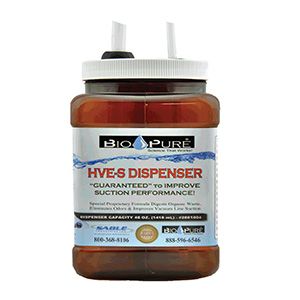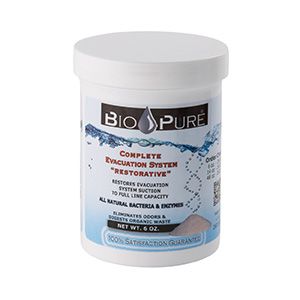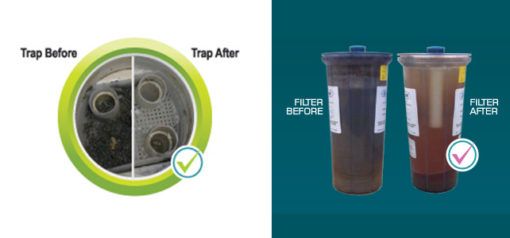Methyl mercury is one of the most toxic elements known to mankind. It is cumulative in the way it is absorbed, it can pass through the blood brain barrier to cause serious mental health disorders, and there is no body organ that it does not harm.

Alexander Bischoff, President of Operation Savannah, Inc
One source of mercury in the environment is dental amalgam, first patented by the ADA as a safe and stable composite for the restorative hygiene of teeth. Although the dental industry has shifted away from using amalgam for restorations, it is estimated that 91% of Americans ages 20–64 still have an average of three dental fillings. The removal of this amalgam generates 4.4 tons of mercury each year.
The safe disposal of dental amalgam falls under a new EPA regulation titled, “Effluent Limitations Guidelines and Standards for the Dental Category, 40 CFR Part 441.”
History:
In 2002, a study jointly funded by the EPA and the American Dental Association (ADA) concluded that pretreatment and best management practices (BMPs) by dental offices would result in a significant reduction of mercury discharged to publicly owned treatment works (POTWs).
In 2004, the ADA and the EPA agreed to a Voluntary Discharge Reduction Program. This voluntary program was not well supported, leading to the EPA signing a Memorandum of Understanding (MOU) with the ADA and the National Association of Clean Water Agencies (NACWA) in 2008 to establish and monitor the effectiveness of this program.
The Amalgam Rule was proposed in October 2014 after agreement that the voluntary program had not adequately reduced amalgam discharges. With input from multiple parties, including the ADA, POTWs, manufacturers, and other parties, the Amalgam Rule was published in the Federal Register on June 14, 2017, and became effective on July 14, 2017.
Overview:
At first glance, 40 CFR Part 441 (The Amalgam Rule) is short and simple. The rule is a new section that has been added to the EPA Pre-treatment Program. This in turn is part of the (CWA) Clean Water Act, pursuant to the Pollution Prevention Act of 1990. While the amalgam rule is silent on authority, oversight and enforcement, these are comprehensively covered in the parent regulations.
Currently Regulated:
Dental offices in the 13 states and other localities where there are existing local pretreatment regulations are impacted differently from dental offices where there are currently no local regulations, and for whom the new rule is the first and only regulation.
For these offices the rule goes into effect on the date they submit their One Time Compliance Report to their Control Authority, per Section 441:50, the deadline for which is Oct 12, 2020. To the date of submittal all local regulations remain applicable. After submittal the rule is primarily applicable, but extended by any local regulations of any higher standard.
Newly Regulated:
The following information is essential for all offices to know. While most dental offices are aware of the need to install an amalgam separator by July 14, 2020, few dental offices fully understand the requirements of the new regulations spelled out in Section 441, specifically with regard to keeping records of inspections, service, and recycling.
For the purposes of the regulation, a Dental Discharger is defined as a facility where the practice of dentistry is performed—including, but not limited to, institutions, permanent or temporary offices, clinics, home offices, and facilities owned and operated by federal, state or local governments—that discharges wastewater to a publicly owned treatment works (POTW).
The rule applies to all dental dischargers, except for those who exclusively practice one or more of the following dental specialties: oral pathology, oral and maxillofacial radiology, oral and maxillofacial surgery, orthodontics, periodontics, or prosthodontics, except for mobile units and except for offices with 100% containment systems.
This rule does not apply to dental dischargers that do not discharge any amalgam process wastewater to a POTW, such as dental dischargers that collect all dental amalgam process wastewater for transfer to a Centralized Waste Treatment facility, or to dental dischargers that do not place dental amalgam, and do not remove amalgam except in limited emergency or unplanned, unanticipated circumstances.
Existing dental dischargers have until July 14, 2020 to install a compliant amalgam separator, while new dental dischargers have 90 days from date of first discharge to a POTW (date office opens) to install a compliant amalgam separator.
The regulatory language details the necessary elements in record keeping, which may not yet be well understood by most dental offices, especially those yet to install a separator.
Every dental discharger is required to submit a One-Time Compliance Report to their Control Authority. For existing dental dischargers this report must be submitted no later than Oct. 12, 2020; for new dental dischargers, the report must be submitted no later than 90 days following the first discharge of wastewater into a POTW. The One-Time Compliance Report must be signed and certified by a responsible corporate officer, a general partner or proprietor, or a duly authorized representative.

Figure 1: Bio Pure cost effective
Every dental discharger is required to submit a One-Time Compliance Report to their Control Authority. For existing dental dischargers this report must be submitted no later than Oct. 12, 2020; for new dental dischargers, the report must be submitted no later than 90 days following the first discharge of wastewater into a POTW. The One-Time Compliance Report must be signed and certified by a responsible corporate officer, a general partner or proprietor, or a duly authorized representative.
For dental dischargers not subject to this rule—those that do not place or remove dental amalgam—the One-Time Compliance Report must include the following: facility name, physical address, mailing address, contact information, name of the operator(s) and owner(s); and a certification statement that the dental discharger does not place dental amalgam and does not remove amalgam except in limited circumstances.
- For dental dischargers subject to this rule, the One-Time Compliance Report is much more complex and must include the following (per 40 CFR 441):
- The facility name, physical address, mailing address, and contact information.
- Name(s) of the operator(s) and owner(s).
- A description of the operation at the dental facility including: The total number of chairs, the total number of chairs at which dental amalgam may be present in the resulting wastewater, and a description of any existing amalgam separator(s) or equivalent device(s) currently operated to include, at a minimum, the make, model, year of installation.
- Certification that the amalgam separator(s) or equivalent device is designed and will be operated and maintained to meet the regulatory requirements.
- Certification that the dental discharger is implementing best management practices (BMPs)
- The name of the third-party service provider that maintains the amalgam separator(s) or a brief description of the practices employed by the facility to ensure proper operation and maintenance.

Figure 2: The Right Microbes & Enzymes
Together for Clean Vacuum Lines
The following records must be maintained and made available for inspection in either physical or electronic form, for a minimum of three years:
- Documentation of the date, person(s) conducting the inspection, and results of each inspection of the amalgam separator(s) or equivalent device(s), and a summary of follow-up actions, if needed.
- Documentation of amalgam retaining container or equivalent container replacement (including the date, as applicable).
- Documentation of all dates that collected dental amalgam is picked up or shipped for proper disposal and the name of the permitted or licensed treatment, storage or disposal facility receiving the amalgam retaining containers.
- Documentation of any repair or replacement of an amalgam separator or equivalent device, including the date, person(s) making the repair or replacement, and a description of the repair or replacement (including make and model).
- The manufacturers operating manual for the current device.
Best Management Practices (BMPs)
Dental offices are advised to pay particular attention to Section E of their One-Time Compliance Report, where the dentist makes their federal declaration to follow these BMPs:
Waste amalgam including, but not limited to, dental amalgam from chair-side traps, screens, vacuum pump filters, dental tools, cuspidors, or collection devices, must not be discharged to a POTW.

Figure 3 & 4:Bio Pure guaranteed to improved suction
Dental unit water lines, chair-side traps, and vacuum lines that discharge amalgam process wastewater to a POTW must not be cleaned with oxidizing or acidic cleaners, including but not limited to bleach, chlorine, iodine and peroxide that have a pH lower than 6 or greater than 8.
Traditional cleaners, with or without enzymes, clean by the chemical action of dissolving accumulated waste. A pH outside the range of 6-8 WILL dissolve the mercury captured in the amalgam container. The rule speaks explicitly to the issue of soluble mercury and the need to minimize it. Cleaners based on microbial science provide an excellent alternative to chemicals.
Now is the time for all dental offices to be looking to their own practices to ensure that they are in compliance with these new regulations.
Alexander (Alex) Bischoff is President of Operation Savannah, Inc. a 501c3 non-profit that provides education to veterans and parents battling PTSD. In 2014, Stephanie Smiles was formed with the mission of using Internet technology to educate and equip the dental industry. Specifically: i) to support dental offices comply with the EPA Amalgam Rule; ii) to understand the challenges facing patients with PTSD or alcohol/drug abuse; and iii) for patients, especially children and young adults, if diagnosed with cancer, to know the importance of having their teeth cleaned prior to any Chemotherapy. Alex and his wife Mary live in Gardnerville, Nevada. He can be found walking Job’s Peak trail, or speaking on a range of subjects, but always seeking to share God’s Grace in truth and love.


